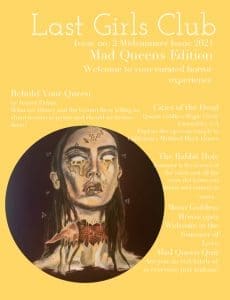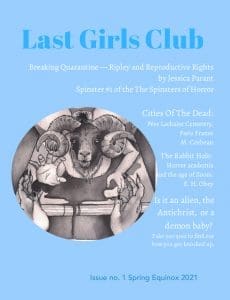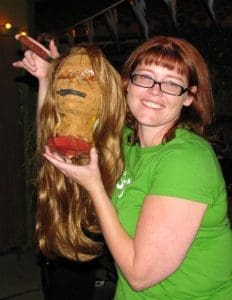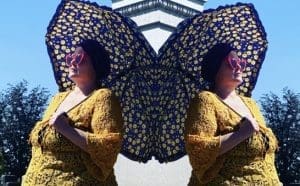Eda Obey & The Last Girls Club: “We Choose What We Bleed Over”
 Eda Obey & The Last Girls Club: “We Choose What We Bleed Over”
Eda Obey & The Last Girls Club: “We Choose What We Bleed Over”
By Angelique Fawns
The Last Girls Club is more than just a magazine, it’s a place where established norms are shredded and rebuilt. Eda Obey has created a “club” for creatives which incorporates a magazine, podcast, newsletter, and any other artistic expression that fits the concept of “indie feminist horror.”
Obey is a fierce voice and aggressively challenges stereotypes and literary preconceptions. She’s already tackled the power dynamic of women in fairy tales and the concept of birth in her first two issues.
The third issue of the magazine drops on Wednesday September 22, and revolves around the theme of “Dark Shadows: The Gay 90s; closeted, cast out, or converted.”
Submissions for the fourth issue, which asks for stories related to devout-martyrs, massacres, and cults, open on Friday October 1.
I sat down with Eda Obey to learn more about her vision and projects.
AF: How did The Last Girl’s Club get its beginnings?
EO: The Last Girls Club is my pandemic love child born from frantic boredom, the refusal to drink myself to death, and the need to indulge in the morgue humor that had overtaken all my human interactions. I was sent home from my job March 16, 2020, and in the never-ending twilight of the pandemic I rediscovered my love for horror. I took a Miskatonic Institute of Horror Studies online seminar on 70s gothic horror comic books in the UK. The comics were like Sabrina the Teenage Witch on crack. That class influenced my vision of The Last Girls Club magazine and website.
(Note for readers: If you are curious about the Miskatonic Institute of Horror, this is the website’s explanation, “Named for the fictional university in H.P. Lovecraft’s literary mythos, the Miskatonic Institute of Horror Studies is an international organization that offers undergraduate-level history, theory and production-based masterclasses. In addition to a September-May curriculum, Miskatonic co-presents events throughout the year.”)
 I missed the tactile thrill of a magazine. I wanted to create something I could hold. I used to love flipping through magazines like SPY, LA Glue, Bitch, Bust, MAXIM, or Propaganda; and reading every last little thing, taking the quizzes, reading my horoscope, seeing pictures of weird places to travel to, and photo spreads of offbeat art installations. I smushed all my favorite bits of that into the Last Girls Club and created my own ghost host, Martinne Corbeau, to be our guide. This is a long form surreal art project for me. Amanda Palmer’s Patreon was very inspiring. She flows with her artistic nature, and hires fellow creatives to ride shotgun on her joyride through life. I’m very free about my creative process. I can let things evolve. Each issue has a beginning theme and my columnists and authors run with it and take it to some amazing conclusions. The summer issue “Mad Queens” became about how women in power are villainized and the fetishistic destructive response society has to them. The fall issue was about being gay in the 1990s and that brought out the issues of gay conversion/exorcisms, gay panic, and coming out to unsympathetic parents. I can’t wait to see what everyone does with the winter theme: Devout-martyrs, massacres, and cults.
I missed the tactile thrill of a magazine. I wanted to create something I could hold. I used to love flipping through magazines like SPY, LA Glue, Bitch, Bust, MAXIM, or Propaganda; and reading every last little thing, taking the quizzes, reading my horoscope, seeing pictures of weird places to travel to, and photo spreads of offbeat art installations. I smushed all my favorite bits of that into the Last Girls Club and created my own ghost host, Martinne Corbeau, to be our guide. This is a long form surreal art project for me. Amanda Palmer’s Patreon was very inspiring. She flows with her artistic nature, and hires fellow creatives to ride shotgun on her joyride through life. I’m very free about my creative process. I can let things evolve. Each issue has a beginning theme and my columnists and authors run with it and take it to some amazing conclusions. The summer issue “Mad Queens” became about how women in power are villainized and the fetishistic destructive response society has to them. The fall issue was about being gay in the 1990s and that brought out the issues of gay conversion/exorcisms, gay panic, and coming out to unsympathetic parents. I can’t wait to see what everyone does with the winter theme: Devout-martyrs, massacres, and cults.
AF: Can you define what “indie feminist horror” means to you?
EO: Indie feminist horror embodies the female gaze unadorned and merciless. It doesn’t owe anything to anyone. Our story doesn’t have to be happy or reestablish social order at the end of it. Our sheroes don’t have to be likable, pliable, child/partner centered, or wrong for not being a predictable archetype. (Fuck the Hays Code bullshit we’ve been conditioned to accept as “normal”) We are the protagonists of our stories; our bodies are not canvasses for others to rip apart or carve their likeness into. We choose what we bleed over. We are the monsters that should be feared. Our virtue is not our value. Tropes are poked and archetypes are deconstructed.
(Note for readers: Hays Code refers to a set of production directives adopted by Hollywood studios starting in 1930 to ensure films weren’t banned. It stifled creative freedom for over three decades.)
AF: You’ve also used the term “problematic fiction” can you expand on what this means to you?
 EO: I’d had the impression that horror is considered to be anti-intellectual or a complete sausage fest. I wanted to challenge that. It was only when I researched further that I found I had been swept along in a global movement of women who were aching to get into the horror discourse. Also, I was writing short stories that didn’t completely fit a certain genre or type and I found it problematic to find venues to submit them to. An exploration of the theory of Resting Bitch Face with the experiences of two sex slaves working to buy their freedom, with a horror ending is a hard sell.
EO: I’d had the impression that horror is considered to be anti-intellectual or a complete sausage fest. I wanted to challenge that. It was only when I researched further that I found I had been swept along in a global movement of women who were aching to get into the horror discourse. Also, I was writing short stories that didn’t completely fit a certain genre or type and I found it problematic to find venues to submit them to. An exploration of the theory of Resting Bitch Face with the experiences of two sex slaves working to buy their freedom, with a horror ending is a hard sell.
(Eda Obey’s short story, “Out of Pocket” https://www.lastgirlsclub.com/wickedtales/out-of-pocket )
I wanted a platform where horror and surrealism intersected, and I wanted to be in charge.
AF: Explain the role and importance of art in your vision and magazine?
EO: I’ve always loved art, especially challenging art, like the Chapman Twins’s art installation “Hell” (2000) or Jan Švankmajer’s Alice (1988). I’m trying to convey that aesthetic in my choices. The cover art is what sets the tone for the issue. I wanted to provide blossoming artists a canvas to push our boundaries and theirs by exploring the theme. Also, to get the opportunity to promote themselves with an artist page if they like. I usually offer a vision and let them run with it. I would love to find a creepy art gallery that submitted a photo spread of artists’ work for each issue.
(Note for readers: Jake and Dinos Chapman created a controversial series of sculptures using 60,000 Nazi figures. Jan Švankmajer’s Alice is a surreal movie adaptation of Lewis Carroll’s children’s book Alice that using stop-motion animation of dead animals and puppets.)
AF: What do you create/write yourself?
 EO: I have an animal fantasy series called The Vermin Chronicles, available on Amazon. I’ve written a splatterpunk novella titled “Killer RV”. That one is languishing in TOR/Nightfire submission purgatory, only 130th in line! In the magazine, I write the Cities of the Dead column, The Rabbit Hole column, Martinne’s stories, the quiz, a short story, and occasionally a poem. That’s quarterly. Monthly, I write a newsletter as Martinne to the readers. It’s usually a roundup of links, a short story or poem I picked from the last issue’s submissions that didn’t make the cut, but I still wanted to publish it (that gets featured on the website’s homepage), and a short story of historical horror from Martinne’s memories of her past lives. Whew! Didn’t realize how much I was churning out. No wonder my brain feels like mac ‘n’ cheese most days.
EO: I have an animal fantasy series called The Vermin Chronicles, available on Amazon. I’ve written a splatterpunk novella titled “Killer RV”. That one is languishing in TOR/Nightfire submission purgatory, only 130th in line! In the magazine, I write the Cities of the Dead column, The Rabbit Hole column, Martinne’s stories, the quiz, a short story, and occasionally a poem. That’s quarterly. Monthly, I write a newsletter as Martinne to the readers. It’s usually a roundup of links, a short story or poem I picked from the last issue’s submissions that didn’t make the cut, but I still wanted to publish it (that gets featured on the website’s homepage), and a short story of historical horror from Martinne’s memories of her past lives. Whew! Didn’t realize how much I was churning out. No wonder my brain feels like mac ‘n’ cheese most days.
AF: I always like to lift the curtain a little bit and find out what publishers do in the “real world.” Do you have a day job?
I’ve been an independent massage therapist since 1998. I spend 3-4 days a week booked with clients and use my down time to write, take online art classes, and learn to play my red clarinet, Lilith. The salon I work out of is very into women’s empowerment. We run a New Moon Healing Circle each month with journaling, breathing exercises, and sound baths to support our local community and hold space for continual healing. I’m very lucky to be able to be openly Pagan and fearlessly engage in witchy things in full view of my clients and community. I sage, I read tarot, I power crystals and water under the full moon and use it to bless things, I perform spells, and pour salt along entryways. Things that were furtive in my native state of Texas I can be open about in California.
AF: Any inside advice/secrets for submitting writers?
 EO: Stories that are on theme have a better chance. Don’t send lurid sex scenes with a murder at the end. Sex is fine, but if takes up more than a few paragraphs, you’re wasting words and world building. Be sure you are writing a story with a beginning, middle, and end; not an excised scene from a larger story we’ll never see. Feel free to get gory. Try to make people surprisingly unlikable. I would love to see more female anti-heroes, like Gillian Flynn’s Sharp Things or Utopia. Get mean, get weird. I’m here for it.
EO: Stories that are on theme have a better chance. Don’t send lurid sex scenes with a murder at the end. Sex is fine, but if takes up more than a few paragraphs, you’re wasting words and world building. Be sure you are writing a story with a beginning, middle, and end; not an excised scene from a larger story we’ll never see. Feel free to get gory. Try to make people surprisingly unlikable. I would love to see more female anti-heroes, like Gillian Flynn’s Sharp Things or Utopia. Get mean, get weird. I’m here for it.
AF: What’s in the future for Last Girls Club?
EO: I’ve got themes into the spring of 2022. I’ll see what inspiration and the zeitgeist brings from there. I’m giving this project 3-5 years to bloom or die. The vision is still growing. Whatever happens, the experience of creating The Last Girls Club universe and collaborating with all the authors, poets, artists, and columnists will be worth any dollar I’ve spent on it. It isn’t a non-profit company, but it is not created for profit. The lack of pressure from advertisers or income goals frees me up to do what I please. It’s exhilarating. Maybe one day it will turn a profit, but it’s not my concern. I once met a publisher of a heavy metal magazine in New Jersey while we were both looking for Jim Morrison’s grave in Pere Lachaise. He said, “You know how to make a little money in publishing? Spend a lot of money on publishing.”
- About the Author
- Latest Posts
Angelique Fawns writes horror, fantasy, kids short stories, and freelance journalism. Her day job is producing promos and after hours she takes care of her farm full of goats, horses, chickens, and her family. She has no idea how she finds time to write. She currently has stories in Ellery Queen, DreamForge Anvil, and Third Flatiron’s Gotta Wear Eclipse Glasses. You can follow her work and get writing tips and submission hints at http://fawns.ca/.












